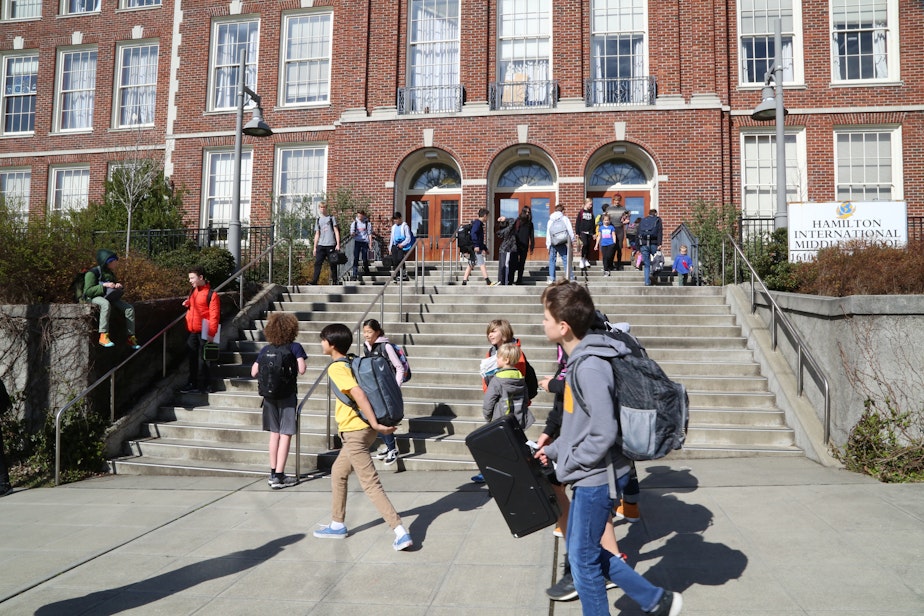Highlights from Seattle Schools' tentative agreement with its teachers union

Seattle Public Schools and Seattle Education Association reached a long-awaited tentative agreement Wednesday that outlines expectations for both sides as the district gears up to begin the school year remotely.
The union is scheduled to vote on the contract Friday and the details have not been released publicly, but a draft obtained by KUOW lays out more concrete expectations of staff and students than in the messy crisis mode of the spring when the pandemic was new. The agreement would also allow schools and staff more flexibility than the district had previously proposed.
In the week leading up to the first day of school on September 4, staff will get six days of training - twice as many as usual - focused primarily on how to effectively teach and work remotely and digitally, as well as on anti-racist practices and social/emotional learning for students and families who have been through the “shared collective trauma of a dual pandemic”: Covid-19 and systemic racism.
In a break from the traditional fall routine, the first 10 days of the school year would be deemed a “Strong Start" focused on connecting with families to make sure they have the technological access they need for online learning. Rather than begin academic instruction, teachers would do two hours a day of “supplemental learning activities” focused on students’ well-being and social/emotional learning.
Academic lessons would begin September 14, which also gives the district more time to receive and distribute laptops, tablets and Wi-Fi hotspots to students who need them.
The typical elementary school day would include:
Sponsored
- A half-hour class meeting
- An hour of English/language arts
- An hour of math
- Half an hour of science or social studies
- An hour of small-group support
- Half an hour in which teachers check in with families
The instructional periods include a combination of live lessons for the whole class, small groups, and independent student work, like assignments or watching pre-recorded videos.
Sponsored
Middle and high schools are given more flexibility about how to hold classes, but with much more structure than in the spring. The school day would be broken into three or four class periods that students would attend on an alternating A/B schedule Mondays, Tuesdays, Thursdays, and Fridays. Teachers would be required to hold at least two live, online classes for each class period during the week, and otherwise assign small-group or independent work.
On Wednesdays, middle and high school teachers would schedule at least 35 minutes to check in with students online and help support their social/emotional needs, plus additional time to do live, small-group instructional support and connect with families.
Teachers in all grades would be required to make video or other recordings of lessons when they introduce new material to help students who were unable to join a live online class, or who want to review it.
Unlike in the spring, teachers will now be required to take attendance by looking at things like students’ daily online log-ins, communications with students, or student participation in a task or assignment. When a student has an unexcused absence, the teacher, attendance secretary or other school staff would be expected to contact their family.
Many families of special education students complained that services for their kids were scarce in the spring - or non-existent. This fall, the district had pledged to serve special education students in-person if their needs could not be met remotely. But the agreement stipulates that the district must first complete a long list of health and safety precautions before requiring staff to meet with students face-to-face.
Sponsored
The most challenging of those precautions for the district is likely the requirements that its HVAC systems and building air-handling equipment are sufficient to prevent the spread of the virus.
Decisions about which students qualify for in-person special education services would be made by the students’ Individualized Education Program team, plus a school nurse or district health services staff.
“Teams will review data to determine if the student requires in-person services to make meaningful progress on their IEP goals and determine how in-person services can be provided safely and in compliance with health guidelines,” the agreement reads.
As for when school buildings will reopen for all students, the district and union would create a joint work group dedicated to reviewing Public Health -- Seattle & King County Covid-19 data and using the health department’s decision tree in order to make recommendations to district leaders about how and when to offer in-person instruction and services.
The tentative agreement is scheduled for a vote of the Seattle Education Association representative assembly on Friday evening. It must then be approved by a vote of the school board.




